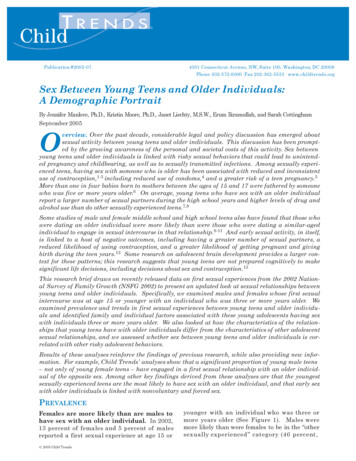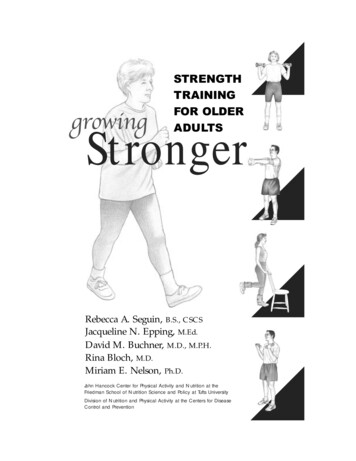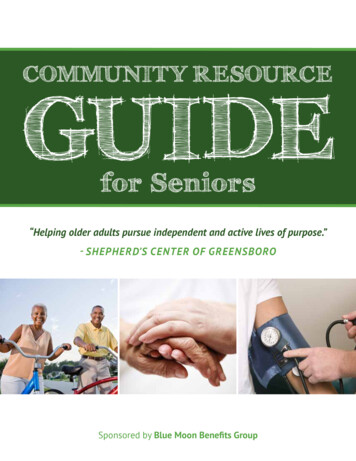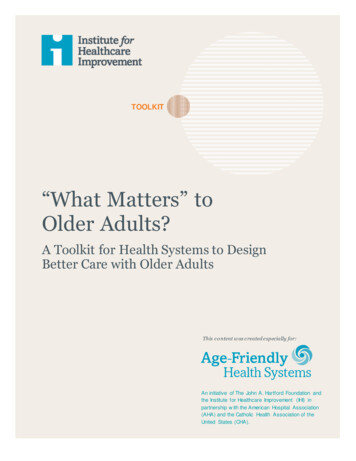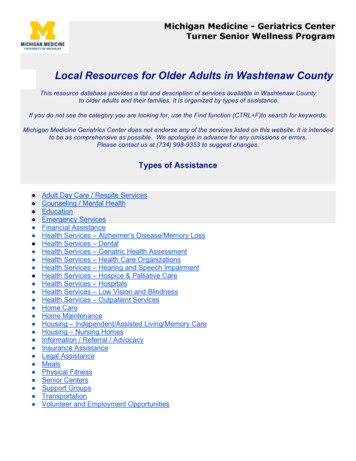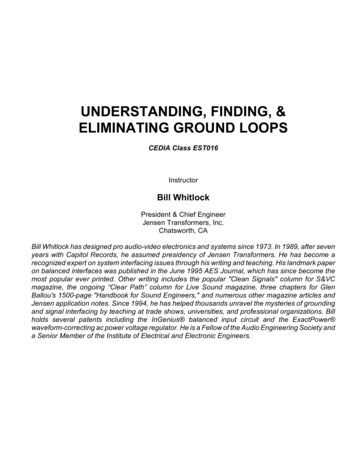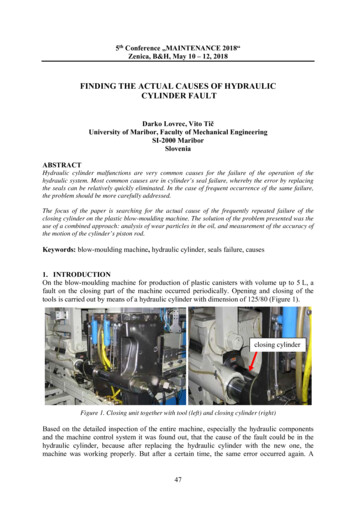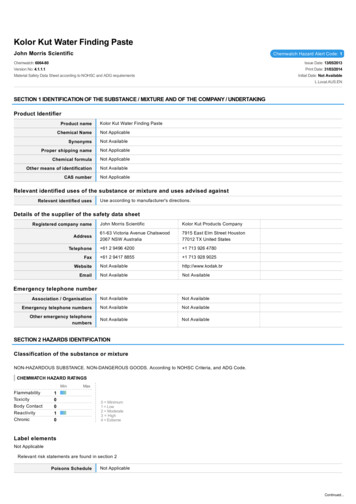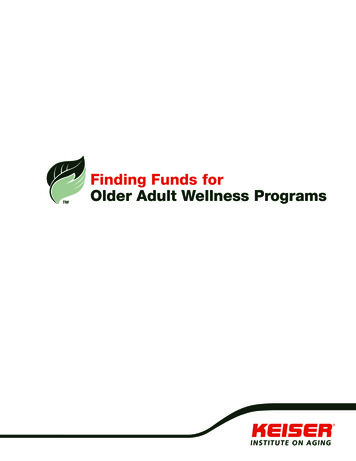
Transcription
Finding Funds forOlder Adult Wellness Programs
Finding Funds forOlder Adult Wellness ProgramsWriting Grants for Older Adult Health and WellnessMany community based groups that provide older adult health and wellness activities do not have the fundsto purchase fitness equipment for their programs.This guide will help you understand how to find potential funders, and write a request for funding that includesfitness equipment. The information can be applied to writing any kind of healthy aging grant but the examplesfocus on writing a request for an older adult program that includes resistance training (RT) as a major programfocus. Partly because RT is what we know best, but also because RT is a highly effective strategy to helpseniors stay healthy and independent.Why Resistance Training as a Program Component?Decades of research prove that resistance training prevents functional decline, reduces risk for falls andreduces risk factors for age-related diseases; all important factors that help older adults stay healthy andindependent. In fact, the American Heart Association, American College of Sports Medicine, and the AmericanDiabetes Association have all endorsed resistance training as an integral part of exercise programs to promotehealth and prevent disease.Resistance programs are evidence-based,easy to implement, use simple assessments to measureimprovement, and are sustainable; everything grant funders require. Yet only a small percentage of older adultshave access to quality RT equipment. We hope this grant primer will change that!Help older adults in your service area improve health and independence. To learn more click hereThe Keiser AdvantageYou don’t have to buy resistance training equipment to use this guide. It’s useful to anyone interested inwriting grants for healthy aging programs. You don’t have to buy Keiser, we just happen to believe that whenyou know what RT can do for older adults, have financial support, and compare Keiser with other resistancetraining equipment, you’ll choose Keiser.To find out more about why Keiser is the best equipment for older adults click hereWhen you choose Keiser you’ll receive a comprehensive training manual, Keiser’s Step in the Right Direction.It outlines how to create a senior wellness center and provides S.T.E.P. (Stability Training Exercise Program)resources to help your program leaders build, manage, and market an effective RT program.To learn more about Step in the Right Direction and see sample S.T.E.P. resources click here
Finding Funds forOlder Adult Wellness ProgramsIndexstarting out1.0 things to consider1.1 What do you want and why do you need it?1.2 Community Partnerships can work for you1.3 Evidence-Based Programs1.4 Finding a Funder1.5 Are You Eligible?searching for2.0 funders online2.1 Look Local First2.2 Searching Online2.3 Searching for Public Fundsthe3.0 big ask3.1 Getting Your Message Across3.2 The Importance of Measurable Objectives3.3 The Project Narrative - Communication is Key3.4 For Each Proposal You Write3.5 Building a Budget3.6 Sustaining the Program After Funds are Depletedputting it4.0 all together4.1 Letters of Support4.2 Full Example Proposal Document
starting out1.0 things to considerWriting a grant, or looking for funding for a good, solid program is not as difficult as you might think. Even ifyou have never written a grant before, follow these simple steps and give some thought to the tips and notes.The examples in the links are based on a FICTIONAL Program called the Elmdale Healthy Living Center.1.1 What do you want and why do you need it?Start from square one what is it that you want? – What do you want to do and what do you need in order todo it?Example: We want to set up a senior wellness center. We need space, staff and equipment.Be prepared to explain: The need for your request, based on actual data How you will document the effect of the program on the people who use it. How you will continue after funding is used up1.2 Community Partnerships can work for youA group formed to share in the finances and/or administration of a grant project can collectively accomplishwhat no one member could accomplish alone.1.3 Evidence-Based ProgramsEvidence-based programs are programs that have already been established and have a proven record ofsuccess. Incorporating an evidence-based program into your plan can help establish credibility. Today,many funders require grantees to include evidence-based programs as part of their plan. Read the fundersrequirements carefully to determine if your program must include an evidence-based component.For more information about Evidence Based Programs click here1.4 Finding a FunderThis can be a complex, but not impossible task. Funding can be found as close to home as your community,and as far away as the federal government.Funding comes from:PUBLIC funders: (government city, county, state, federal)PRIVATE funders: (philanthropic foundations, individuals, companies that provide support to projects of interest).Funding goes to:Private non profits: (tax-exempt under section 501(c)(3) of the Internal Revenue Code not organized for profitand none of net income benefits any private stockholder or individual).Government Agencies: (tax exempt agencies of a city, county, state or federal program)1.5 Are You Eligible?Funders sometimes have restrictions on the kinds of agencies and programs they will fund. Before you start besure you are eligible. If you have questions it is best to call the funder directly.Consider forming a community partnership or consortium: A group formed to share in the finances and/oradministration of a grant project to collectively accomplish what no one member could accomplish alone.When calling a funder, remember you are putting “voice” to your potential application. Be sure to have a list ofquestions, and be sure those questions have not already been addressed in the documents you find on the website. Is there a Frequently Asked Questions section?1
searching for2.0 funders online2.1 Look Local FirstLooking for funds from your local community may help cut competition, BUT local funders may not be a goodmatch for your program ideas or financial needs. Be flexible and remember that all funds do not have to comefrom one place.2.2 Searching OnlineWhat you type in the browser bar is very important. Try a number of different words and combinations of thosewords to see what comes up.Examples:grants, elderly, health, Yourtown - will narrow your search to the local area but will give a different picturethan if you include the word foundation.foundation, grants, elderly, Yourtown - brings up more specific informationfoundation, grants, aging, Yourtown - brings up a different listfoundation, grants, elderly - (without using the city name) widens the search to the national levelRemember - the wider the search, the more competition you may encounter ( Your town, state, region, nationwide ).Click the links to see more information. You may be linked to the home page of the funder or you may find information that can take you to the home page. You can also search for the websites of specific funders whenyou know their names.TIPS:1.Find a funder that is interested in supporting your needa. The closer the match the betterb. Local funders may be less competitive and easier to work with than statewide or national groups2.Go to the funders website to look for:a. Grants that have been funded in the recent past (provide good information on the types ofprograms of interest to the funder)b. Guidelines / deadlines3.Gather information on funders that may be a ‘best fit” for your need. Bookmark thosewebsite visits so you don’t loose them. Keep notes if needed.NOTE: Keep an open mind and think about how your plan will meet the funder’s expectations. Also, be flexible enough toadd components that make your “big ask” a stronger match to the funders’ goals.2.3 Searching for Public FundsEach state has designated Area Agencies on Aging (AAA’s) that administer funds from the Federal governmentthrough the Older Americans Act. In some cases, they are also designated to receive special program grantfunds from the federal government that come through the state level or directly to the local AAA.Title VI, Grants for Indian Tribal Organizations, was included in the 1978 Amendments to the OAA. Title VINative American aging programs provide nutritional and supportive services to older American Indians, AlaskanNatives and Native Hawaiians and provide services to their elders comparable to services offered to other olderadults by AAAs.To find out how to contact your local area agengy on aging, go to n4a.org and click on About N4A – AAA’s/Title VI.NOTE: There may also be grant funds available through your city, county or state government. Your city, county or statemay also have funding for local agencies through contracts. Your agency may also be eligible to provide services under acontract for services. The contracting process is different from applying for a grant. Each locality is different. Check the webfor public funds in your community.2
the3.0 big askDeveloping a win-win plan is important. You want something from funders, but funders expect something fromyou in return.3.1 Getting Your Message AcrossBEFORE you begin to write your request, develop a clear narrative describing your program.Two ways to ask:RFP: Request For ProposalYOUR response to detailed requirements as stated in a formal Request For Proposal issued by a privatefoundation or government agency. For a Sample RFP click hereRequest for FundingA “pitch” of your idea to a foundation. Usually requires an invitation to apply after an initial discussion or letterdescribing your project.Either way: Pick a funder with a mission that best fits your program idea. Determine what kind of ASK you will have to prepare.º RFP responseº Request for fundingLetter of IntentYou may have to submit a letter of intent or a preliminary proposal designed to show your intent to apply (inresponse to an RFP) or to show the grant maker the credibility of your agency and project idea (request for funding).For an example of a letter of intent click hereContact the foundation by email or phone to talk with them about the grant, and if possible, arrange ameeting to talk face to face. The ability to impress the funder when stating your case can make or breakyour effort. Be sure to READ and UNDERSTAND the mission and vision of the funding agency as statedon their home page. Make sure your proposal speaks to their expectations and pay attention to guidelines,instructions and deadlines.3.2 The Importance of Measurable ObjectivesFunders want to know that their money has not been spent frivolously. Measurable objectives are an importanttool for assessing the effect of a program. In order to develop measurable objectives you must first decide whatthe OUTCOME of your program will be .What will HAPPEN because of your program?An easy way to develop goals and objectives is to use the S.M.A.R.T. formula.Specific: what will you accomplish?Measurable: How will you know / show you have reached your goalAchievable: Is this a realistic goal? Do you have the necessary resources?Relevant: why is this goal important?Timely: what is your time frame for achieving your goal?For an example of how to show measurable objectives using the SMART formula click here3.3 The Project Narrative - Communication is KeyBefore you begin you should have some clear and concise information on the following: Who you are The history of your agency – how long have you been around? If a new venture, what are thecredentials of the people involved? What you do now (your wider mission) What you propose to do with these specific funds? Develop a strong introductory statement. It should be short and sweet but hit all of the high points.For an example of an introductory statement click here3
Who do you serve?Characteristics of your general target population - age range, ethnicity, economics, geographic locationº The target population for the planned program (may be the same as the general population,or a segment of it; minority groups, income level, geographic area .etc). Use hard numbersthat can be documented and validated from census data or your agency records.Census data for your locality can be found on the web. Just type census data, and your state in your browser’s search bar. What you want to do for the target population?Your program idea should be built around the funders mission.º How will the program be organized?º How will it work?For a description of an agency and population served click here Why is it important to do this? (needs assessment)º Have documentation on the need for the program. A good needs assessment is VERY important.Needs assessment documentation should be hard evidence for the NEED for the program.For an example of a Statement of Need click here What is the predicted benefit/effect on your target population?º This is a restatement of your goal(s)/objective(s). It can be included in the project description.Be certain the effect on the population is directly tied to the needs assessment and the goals andobjectives you developed in your SMART goals process. If the needs assessment shows a needfor fall prevention then the narrative should show clearly how the program would reduce falls or riskfor falls. How will you measure the effect of the program? (data gathering)This depends on WHAT YOU SAID YOU WANTED TO DO. So be careful to be sure that the success ofyour program IS measurable with the resources and abilities you have at hand.º Describe clearly how you intend to SHOW you have reached your stated goals. This can be a simple as counting how many people participated in an activity before andafter your program started or as complex as doing a formal statistical analysis of theeffects of a program on some specific factor.º If your measurements will be complex, you may need to take on a research partner to help yougather data and analyze results.º If you don’t have a research partner, you should keep your goals very simple so that your effect iseasier to measure.For an example of how to include data collection and analysis into measurable objectives click hereFor an example of the Standard pre and post test for function (Rikli and Jones) click here3.4 For Each Proposal You WriteIt is usually not a good idea to submit identical “boiler plate” RFP’s to multiple funding agencies. You can“recycle” parts of your narratives relating to your agency and program, but you should do your homework andtailor responses to each funder’s interests and needs.Take another look at all the information you gathered - then look at the RFP requirements and plug yourinformation into each section as required by EACH funder. Don’t be too wordy but be sure you are clear. It islikely that you are describing your agency and program idea to people who are not familiar with you or yourservices.Your proposal will be judged on content and presentation. Do not include information that is not relevant to yourrequest. READ the guidelines from the funding agency and write your proposal exactly as described.Be sure to put your proposal in the format requested by the funder. Many foundations will not even look at aproposal that is not laid out according to their instructions.4
3.5 Building a BudgetBe sure to determine allowable budget items. Some foundations will not fund staff, some will not fund bricksand mortar (new construction or renovation), and some will not fund purchase of fixed assets (equipment thatis not used up in the program).NOTE: Fitness equipment is most likely considered a fixed asset. If you are planning to request funds for fitness equipmentor other fixed assets, you should develop a very sound rationale for the need, and have a very strong case for sustainabilityof your program after funds are used up. Cash MatchSome funders require a cash match. This is a cash contribution made directly to and specifically used in theproject by you in addition to the grant funds. In-Kind ContributionFunders may ask you to document IN-KIND contributions – or may require a certain percentage of the grantbudget to be made up through in kind contribution. These are the documented fair market value of NON CASHgoods and services that YOU contribute to the funded project. They must directly benefit or be specifically usedin the project. In kind contributions can be equipment, supplies, or other tangible resources (phone, printing,utilities) that you will supply, (not those that you will purchase or pay for with grant funds).NOTE: Some organizations may also donate the use of office space, activity space or staff time as an in-kind contribution.For a sample budget template click hereFor a sample budget narrative click here3.6 Sustaining the Program After Funds are DepletedMost funders want to know how you’ll keep the program going when the funding is gone. Have a plan and stateit clearly. Developing relationships with community partners is a good way to support sustainability.For an example of how partnerships can support sustainability click hereputting it4.0 all together4.1 Letters of SupportLetters of support from community partners or others who will help to support your program may be required.When asking for a letter of support, it is helpful for you to send an overview of the program and the grantrequest to the person who will write the letter. DO NOT submit a number of identical letters signed by differentagencies.For an example of a request for a letter of support click here4.2 Full Example Proposal DocumentFor an example of a full proposal document based on our RFP example click hereSpell check, proofread, and have someone who did not work on the document review it and comment onclarity and “readability”. Be sure you read the foundation instructions for formatting and presentation and followthem to the letter. Many funders will not even read a proposal that is not formatted according to their instructions.NOTE: You can often find full copies of successful proposals at websites of foundations and funders. These will also giveyou a feel for the style and format of previously funded requests.5
When you choose Keiser you’ll receive a comprehensive training manual, Keiser’s Step in the Right Direction. It outlines how to create a senior wellness center and provides S.T.E.P. (Stability Training Exercise Program) resources to help your program leaders build, manage, and market an effective RT program.File Size: 645KB



